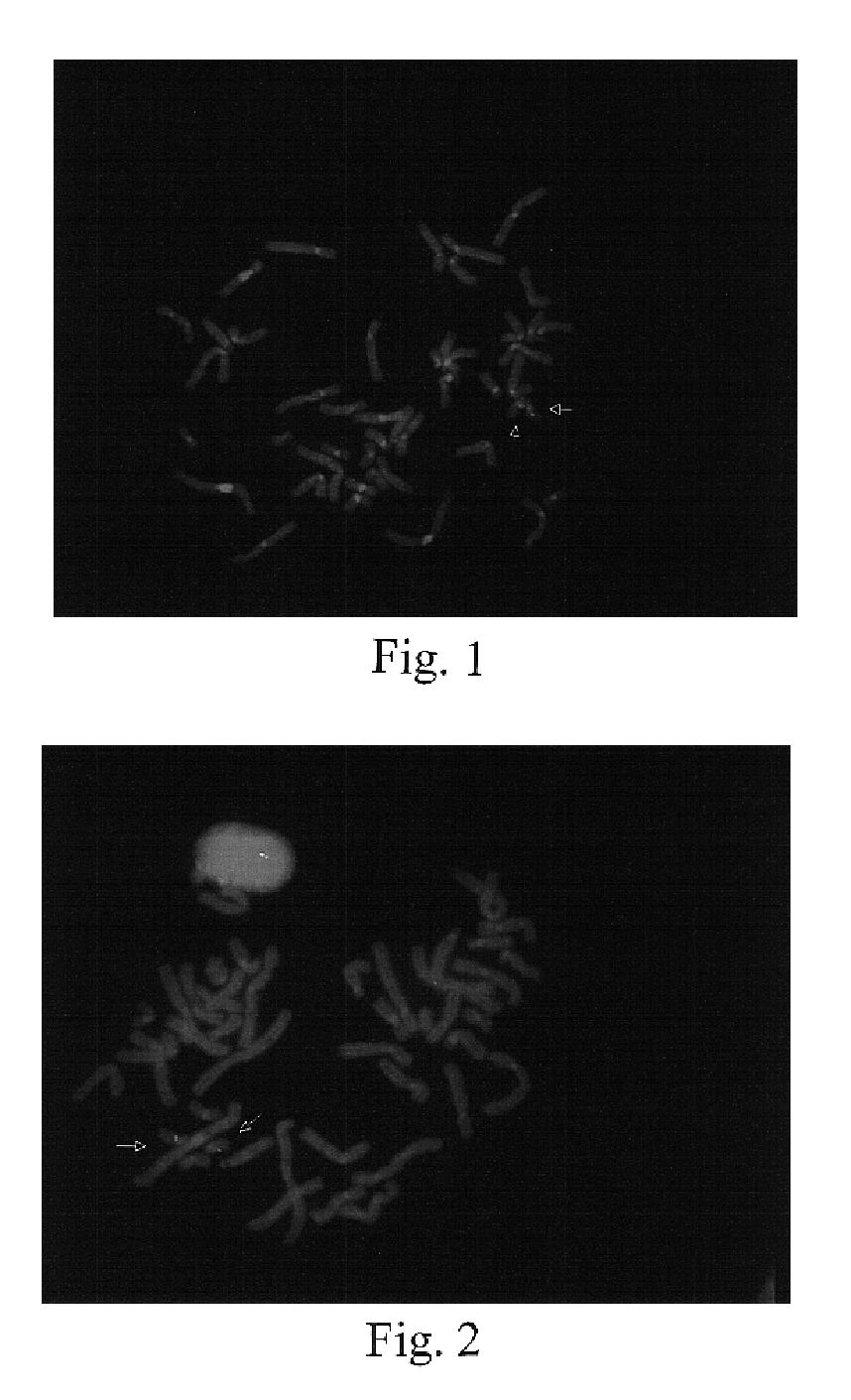Chromosome structural abnormality localization with single copy probes
a single-copy, chromosome technology, applied in the direction of biochemistry, sugar derivatives, organic chemistry, etc., can solve the problems of reducing the sensitivity of existing probes, 100 copies of multi-copy repetitive sequences, and essentially benign, serious or even lethal, and achieves stronger hybridization and increased target sequence length
- Summary
- Abstract
- Description
- Claims
- Application Information
AI Technical Summary
Benefits of technology
Problems solved by technology
Method used
Image
Examples
example 1
Development of HIRA Gene Probe
[0085]A known genetic disorder on human chromosome 22 involves a deletion of one HIRA gene in chromosome band 22q11.2, i.e., in normal individuals, there are two copies of the HIRA gene, whereas in affected individuals, only one copy is present. This deletion is considered to be a cause of haploinsufficiency syndromes such as DiGeorge and Velo-Cardio-Facial Syndromes (VCFS), because insufficient amounts of gene product(s) may disrupt normal embryonic development (Fibison et al., Amer. J. Hum. Genet., 46:888-95 (1990); Consevage et al., Amer. J. Cardiol., 77:1023-1205 (1996)). Other syndromes including Cat Eye Syndrome and derivative chromosome 22 syndrome result from an excess of genomic sequences from this region (Mears et al., Amer. J. Hum. Genet., 55:134-142 (1994); Knoll et al., Amer. J. Med. Genet., 55:221-224 (1995)). Typically individuals with these syndromes have supernumerary derivative chromosome 22s.
[0086]Initially, a computer-based search us...
example 2
Development of NECDIN and CDC2L1 Gene Probes
[0112]The techniques described in Example 1 were used to develop a series of probes for detecting known genetic disorders on chromosome 1 (Monosomy 1p36.3 syndrome; Slavotinek et al., J. Med. Genet., 36:657-63 (1999)) and on chromosome 15 (Prader-Willi and Angelman Syndromes). Approximately 70% of patients with Prader-Willi or Angelman syndrome exhibit hemizygous deletions of the sequence containing the NECDIN gene (Knoll et al., Amer. J. Med. Genet., 32:285-290 (1989); Nicholls et al., Amer. J Med. Genet., 33:66-77 (1989)). The presence of excess copies of this gene is diagnostic for an abnormal phenotype in patients with interstitial duplication or a supernumerary derivative or dicentric chromosome 15 (Cheng et al., Amer. J. Hum. Genet., 55:753-759, (1994); Repetto et al.,Am. J. Med. Genet., 79:82-89, (1998)). The following Table 3 sets forth the deduced single copy intervals, PCR primer coordinates, SEQ ID Nos., and the lengths of the r...
example 3
[0120]In this example, a number of probes specific to additional genetic disorders and cytogenetic abnormalities were developed using the principles of the invention. Software was also developed and improved to expedite the process of designing single copy probes (findi.pl, prim_wkg, and prim, referred to above and provided on the accompanying CD-R). The probes were subsequently tested and their utility confirmed by in situ hybridization.
Identification of Single Copy Sequences
[0121]The locations of single copy probe sequences are determined directly from long contiguous genomic DNA sequences. The locations were determined by software that aligns the sequences of repetitive sequence family members with the target genomic sequence. Comparison of the target sequence with previously determined sequences of repetitive family members served to identify and delineate the bounds of repetitive elements within the target. The computer program, RepeatMasker (genome.washing-ton.edu / RM / RepeatMas...
PUM
| Property | Measurement | Unit |
|---|---|---|
| Tm | aaaaa | aaaaa |
| temperature | aaaaa | aaaaa |
| temperature | aaaaa | aaaaa |
Abstract
Description
Claims
Application Information
 Login to View More
Login to View More - R&D
- Intellectual Property
- Life Sciences
- Materials
- Tech Scout
- Unparalleled Data Quality
- Higher Quality Content
- 60% Fewer Hallucinations
Browse by: Latest US Patents, China's latest patents, Technical Efficacy Thesaurus, Application Domain, Technology Topic, Popular Technical Reports.
© 2025 PatSnap. All rights reserved.Legal|Privacy policy|Modern Slavery Act Transparency Statement|Sitemap|About US| Contact US: help@patsnap.com



